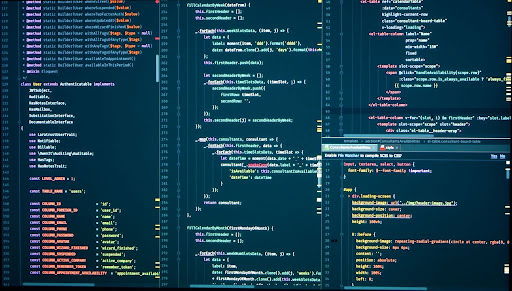The Role of Python in Web Development Frameworks

In the field of web development, frameworks provide a solid foundation for building efficient and scalable applications.
To build the best website, you need the best web development frameworks, which you can build with Python. A versatile and widely adopted programming language, Python plays a pivotal role in numerous web development frameworks.
Web development frameworks offer pre-built tools, libraries, and conventions that streamline development. Python's popularity and expressive syntax make it an ideal choice for web development, leading to the emergence of robust frameworks such as Django, Flask, and Pyramid.
The easy-to-read language and extensive ecosystem of third-party libraries make Python an excellent choice for web development, regardless of the scale of the project.
Python empowers web developers to unleash creativity and build immersive websites that captivate users. With Python driving the development process, web development services can deliver exceptional client results, creating websites that leave a lasting impact.

Django: A Full-Featured Web Framework
Django, a renowned web framework, empowers developers to build robust and scalable web applications easily. Packed with rich features, Django simplifies the development process while maintaining flexibility and extensibility.
At the core of Django lies its Model-View-Controller (MVC) architecture, known as Model-View-Template (MVT). This architectural pattern separates data modeling (model), user interface (view), and application logic (controller) for enhanced code organization and maintainability.
With Django, developers gain access to a plethora of built-in functionalities, including an ORM (Object-Relational Mapping) for seamless database interactions, a powerful templating engine, automatic admin interface generation, and robust security measures.
However, as leveraging Django is a complex process, to streamline the implementation, you can bring in an expert from a Python development company that carries considerable experience in Django implementation.
Flask: Lightweight and Flexible
Flask is a lightweight web framework that offers an elegant and simple approach to building web applications. With its minimalistic design, Flask allows developers to create modular, scalable, and customizable applications with ease.
One of the key advantages of using Flask is its microframework approach which emphasizes simplicity over complexity. This means developers can quickly build small to medium-sized projects without worrying about bloated codebases or unnecessary features.
With Flask's modular design, you have complete control over your application's architecture, making adding new functionality as needed easy. Whether building a RESTful API or a full-fledged web application, Flask has everything you need to start quickly and efficiently.
Pyramid: Versatile and Scalable
Pyramid is a web framework built on Python that emphasizes flexibility, scalability, and simplicity. Its architecture is based on the philosophy of "start small and grow as needed," allowing developers to build applications that can scale easily.
With its modular design, Pyramid offers several key features, such as URL routing, templating engines, support for multiple database backends, and user authentication. This makes it ideal for building complex web applications with minimal coding effort required.
One of the most significant advantages of using Pyramid is its ability to handle large-scale projects without sacrificing performance or maintainability. With its emphasis on modularity and scalability, developers can easily add new functionality as needed while ensuring codebases remain manageable over time.
With Pyramid, Python development companies can unlock the full potential of their web applications, creating versatile and scalable solutions that cater to the unique needs of their clients.
Web2Py: Secure and Easy-to-Use
Web2Py is a web framework built on Python that offers developers an easy-to-use approach to building secure and robust web applications. With its focus on simplicity, Web2Py allows developers to create complex applications with minimal coding effort required.
One of the key advantages of using Web2Py is its emphasis on security. The framework includes several built-in features such as input validation, cross-site scripting (XSS) prevention, and protection against SQL injection attacks.
The framework's user-friendly design enables developers to prototype and deploy applications with ease quickly. Its intuitive interface, integrated development environment (IDE), and automatic administration system simplify the development process, making it an excellent choice for developers of all skill levels.
CherryPy: Minimalistic and High-Performance
CherryPy is a minimalistic web framework built on Python that offers high-performance capabilities for developing web applications. With its lightweight design, CherryPy provides developers with an easy-to-use toolset that focuses on speed and simplicity.
One of the biggest advantages of using CherryPy is its ability to handle large amounts of traffic without sacrificing performance or stability. Its modular architecture allows developers to create scalable applications that adapt to changing needs over time.
CherryPy also includes several key features, such as support for multiple protocols (HTTP, HTTPS), URL mapping, session management, and more, making it an ideal choice for building robust web applications with minimal coding effort required.
TurboGears: Full-Stack Framework
TurboGears is a full-stack web framework built on Python that offers developers an integrated set of components for rapid web application development. With its modular design, TurboGears allows developers to choose the necessary tools without sacrificing performance or simplicity.
One of the key advantages of using TurboGears is its emphasis on integration. The framework includes several built-in components such as SQLAlchemy (database management), Jinja2 (templating engine), and more, making it easy to build complex applications with minimal coding effort required.
With its focus on modularity and flexibility, TurboGears provides developers with all the tools needed to build scalable applications that can adapt to changing needs over time.
Choosing the Right Framework
Selecting the proper web development framework is crucial to building successful applications that meet your project requirements. When choosing a Python framework, it's essential to consider factors such as scalability, flexibility, and ease of use.
Each Python framework offers unique advantages and disadvantages depending on your project needs. Django excels in handling complex databases, while Flask provides an easy-to-use microframework approach for smaller projects. Pyramid emphasizes modularity and scalability, while Web2Py prioritizes security.
By carefully evaluating and comparing Python frameworks, you can select the one that offers the right features and benefits for your project. Choose wisely, as the right framework can significantly impact your development process, productivity, and the success of your web applications.
Beyond the Frameworks: Python Web Standards
Beyond just the frameworks, there are web standards for Python that offer interoperability and compatibility between different frameworks. Two such standards are WSGI (Web Server Gateway Interface) and ASGI (Asynchronous Server Gateway Interface).
WSGI is a standard interface between web servers and Python applications that allows developers to write reusable code across multiple web frameworks. ASGI extends this concept by allowing for asynchronous communication with clients.
By adhering to these standards, developers can build applications that work seamlessly with different servers and frameworks while maintaining high performance and scalability.
So Consider these vital standards when planning your next Python web development project, as adhering to them will create successful, interoperable applications.
Conclusion
Python's diverse web frameworks, including Django, Flask, Pyramid, Web2Py, and CherryPy, empower developers worldwide. Finoit, led by CEO Yogesh Choudhary, continues to leverage these tools, ensuring innovative and reliable web solutions. Python's dominance in web development remains unmatched, shaping the digital landscape with its flexibility and power.
We encourage you to explore these frameworks further and experiment with different approaches to discover the perfect fit for your next project.



